Summer means the ocean and seashells to us! We like to get creative with our summer science experiments, so we had to try this seashell crystal craft. This is the perfect, quick and easy science experiment to set up and forget! Mix the solution and set it aside. Over 24 hours, you can observe some neat changes! Make crystals on seashells with borax is a fantastic STEAM project for kids!
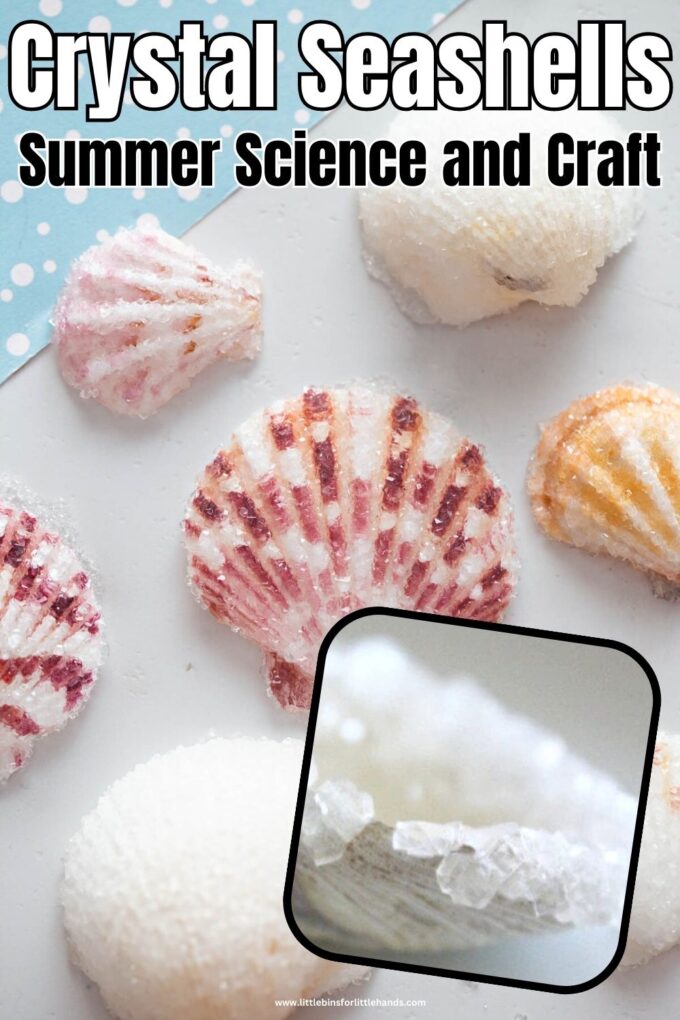
Grow Crystal Seashells Overnight!
For summer science, we experimented with growing borax crystals on seashells. Our seashells come from a beach, but you can easily pick up a bag of shells to try at home if you don’t live near the beach.
Make science exciting for kids by finding fun ways to introduce science learning. Growing crystals is perfect for an easy chemistry experiment at home or in the classroom. Learn about saturated solutions, suspension liquids, ratios, and crystals!
Watch the Seashell Crystal Craft Video:
Things to Do with Seashells
This crystal seashells activity makes a fun science craft you can display. These crystals are pretty hardy, even for little hands. Due to the chemicals involved, this isn’t a very hands-on science activity for young kids, but it’s great for practicing observation skills.
You can always try growing salt crystals as a safe alternative for the younger scientist!
To make this crystal craft, you only need two ingredients, water and powdered borax {found in the laundry detergent aisle}. Additionally, you will need a handful of shells and a flat container. The seashells should not touch each other.
Check out the bottom of this page for alternative ways to grow crystals with kids! While you’re at it with seashells, try this quick ocean acidification experiment dissolving seashells.
You can also set up this simple ocean sensory bin with the extra seashells!
Next time you are at a beach, bring a handful of shells home. Craft stores also sell seashells by the bag. An ocean theme crystal craft is perfect early learning science with excellent visual results!
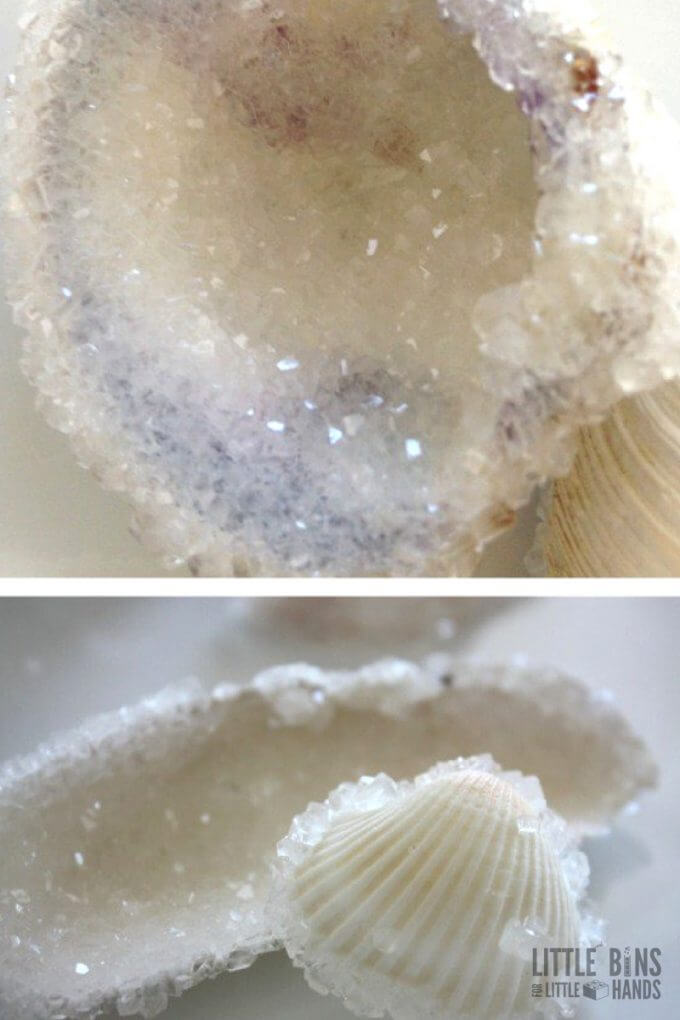
How To Make A Crystal Shell Craft
Supplies:
- Borax Powder
- Water
- Measuring Cups and a Tablespoon
- Spoon
- Mason Jars or Glass Containers
- Seashells
Making a Saturated Solution to Grow Crystals
The most important part of growing these fun crystal seashells is mixing up a saturated solution. The saturated solution will allow the crystals to form slowly and correctly. A saturated solution is a liquid filled with particles until it can no longer hold more of the solid.
TIP: Get your water hot first to make the best saturated solution. As the water heats up, the molecules move away from each other, allowing the solution to hold more of the borax powder. This is a great opportunity to do an experiment and test cold water too!
STEP 1: Boil Water
STEP 2: Add 3-4 Tablespoons of borax powder per 1 cup of water.
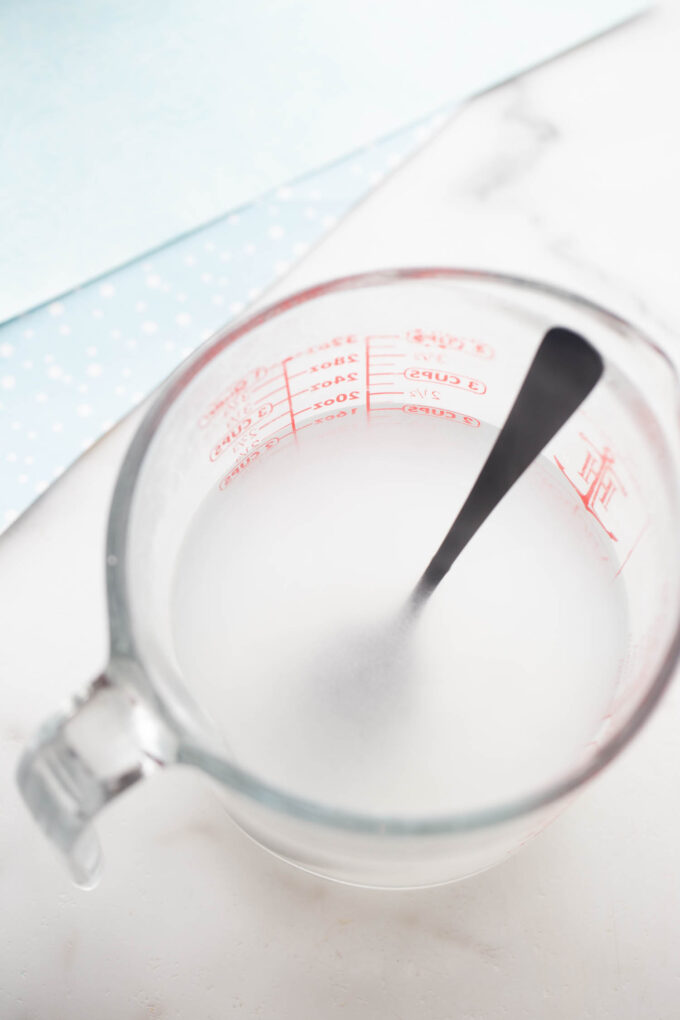
If you do several seashells, make a 3-cup solution to get started. When mixing the solution, you will still see a tiny bit of the powder floating around and settling to the bottom. That means it’s saturated!
STEP 3: Place your seashells in glass containers (glass prevents the solution from cooling down too quickly)
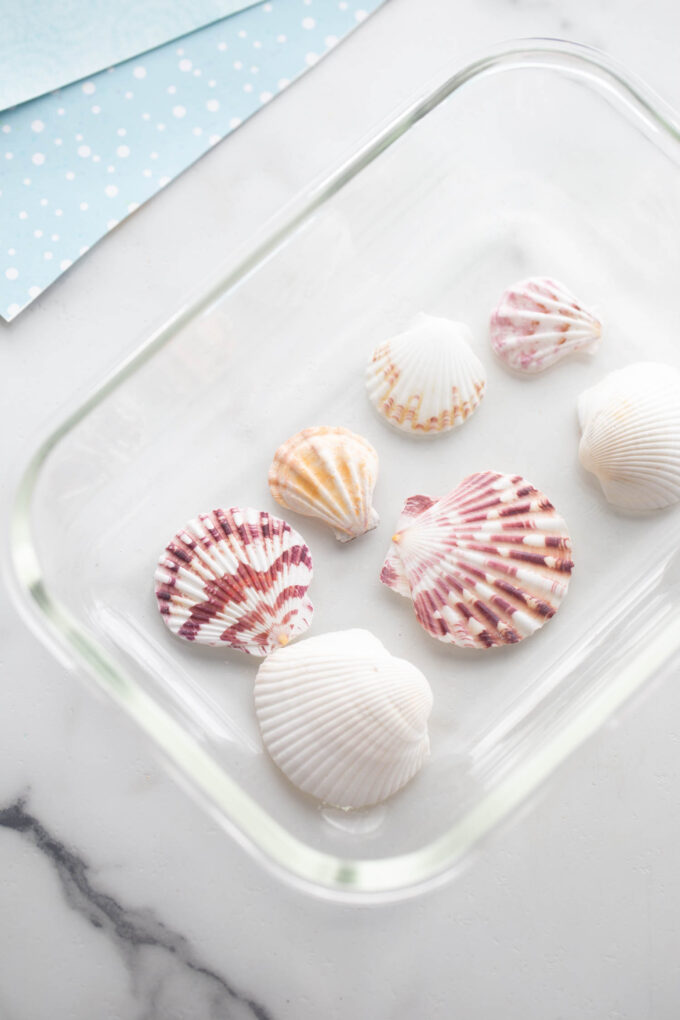
STEP 4: Add the solution to the glass containers and cover the shells entirely.
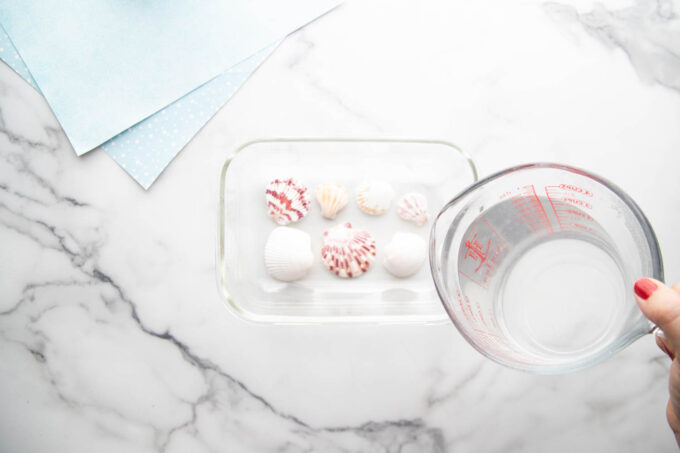
STEP 5: Put it aside and observe what happens.
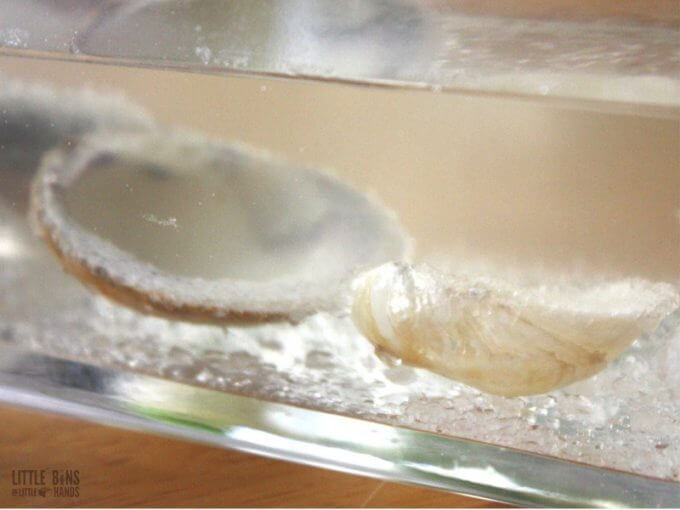
The Science of Growing Borax Crystals
This seashell crystal craft is also a suspension science experiment for incredible chemistry. When the borax is mixed with hot water, it remains as solid particles. As the water cools, the particles settle and form the crystals.
Pipe cleaners also work well for growing crystals. Check out how we made a crystal rainbow with pipe cleaners.
As the solution cools down, the water molecules come back together, forcing the particles out of the solution. They land on the nearest surfaces and continually build up to form the perfectly shaped crystals you see. Make sure to note whether the borax crystals look the same or different from each other.
If the solution cools down too quickly, the crystals form irregularly because they don’t have a chance to reject the impurities also contained in the solution. You should try to leave the crystals untouched for about 24 hours.
TIP: Set the container in a quiet area where kids can check on the crystals without moving the containers. You do not want to jostle the mixture.
After 24 hours, you can take the crystal seashells out and dry them on paper towels. Set up an observation station for the kids to look at the crystals. Have them describe what they look like and even draw them!
Did you know you can also Dissolve A Seashell for more cool chemistry? Click here.
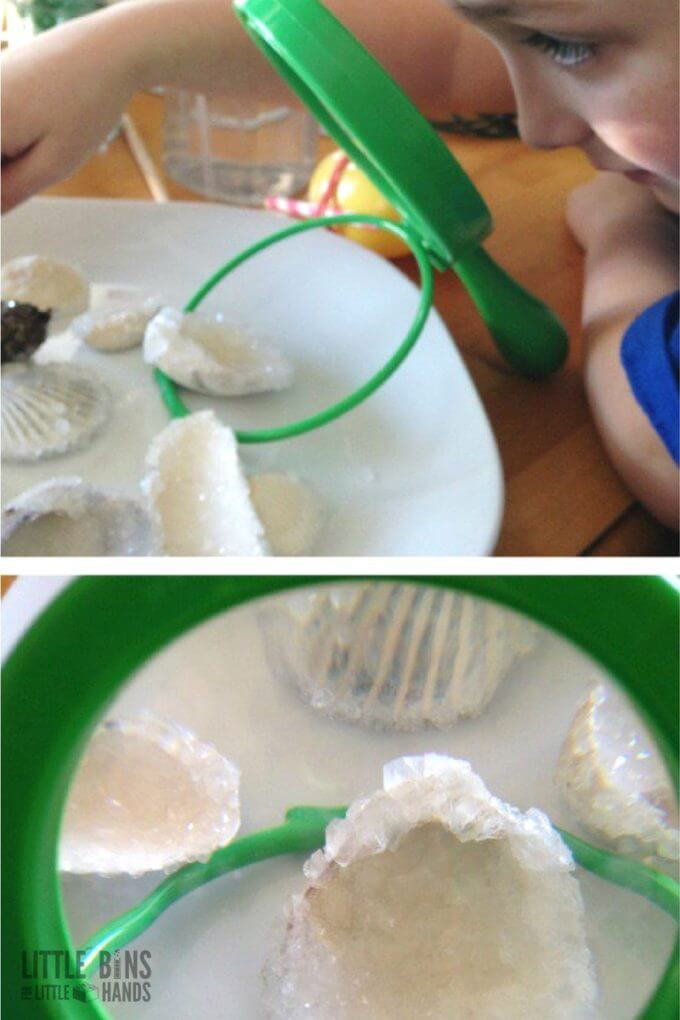
Our seashell crystal craft still looks lovely after a few weeks if left undisturbed. My son still enjoys examining the crystal seashells from time to time. He also shows them off to guests when we have company!
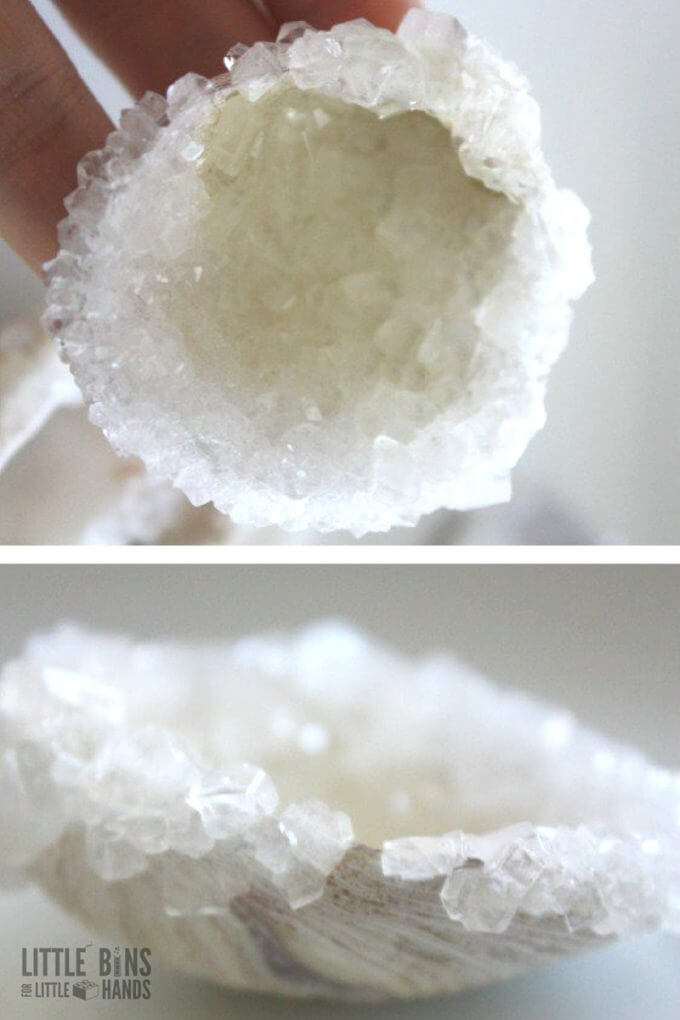
More Crystal Craft Ideas To Try
You can make a different crystal craft for each season, and it’s easiest to use pipe cleaners to create fun seasonal or holiday themes!
- Crystal Candy Canes
- Crystal Snowflakes
- Salt Crystal Snowflake
- Crystal Hearts (Valentine’s Day Favorite)
- Salt Crystal Hearts
- Crystal Rainbow
- Crystal Flowers
- Salt Crystal Leaves
Different Ways To Grow Crystals With Kids
Here are various ways to grow crystals with kids that use borax, sugar, and salt! Did you know rock candy is a crystal?
Salt crystals are also fascinating to grow. Both sugar and salt crystals do take longer to grow than borax crystals. Eggshell geodes look so pretty and use the borax crystal recipe as well!
Even more ocean science fun for kids!
We have a complete line up of ocean science experiments, projects, and activities the kids will love!
Printable Ocean Activities Pack
If you want to have all of your printable ocean activities in one convenient place, plus exclusive worksheets with an ocean theme, our 100+ page Ocean STEM Project Pack is what you need!
Check out The Complete Ocean Science and STEM Pack in our SHOP!
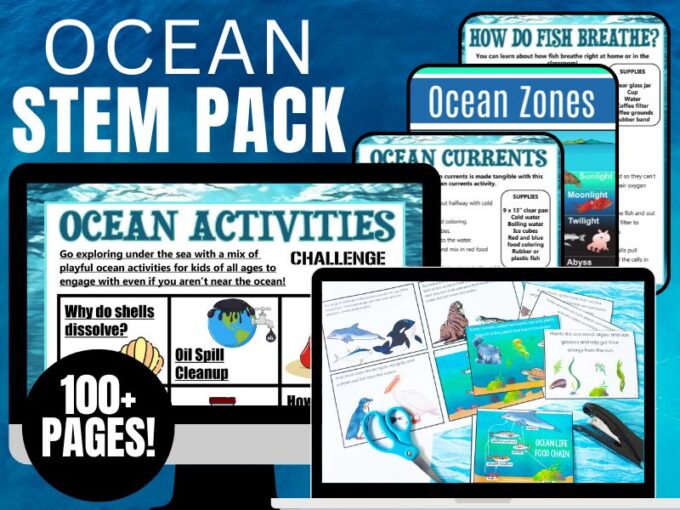


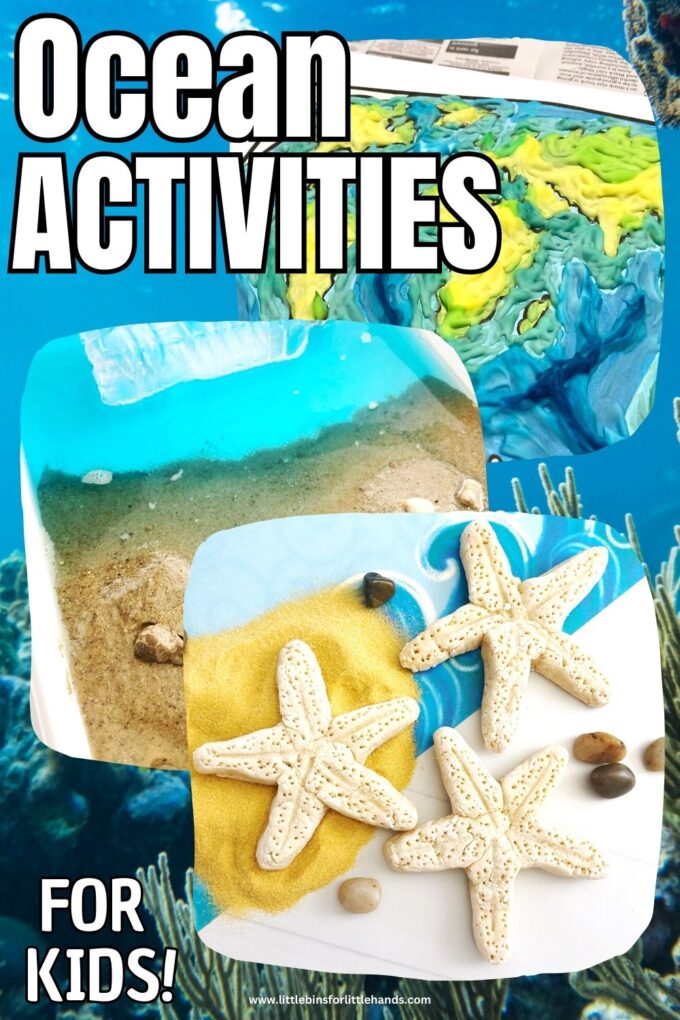






No where that I can see do you talk about the issues of safety around borax. This is something I pulled off the web:
Borax is quite popular online these days. It’s in recipes for everything from children’s craft concoctions to alternative cleaning products and homemade baby wipe solutions. Before you use it, though, make sure you know all the facts.
Borax, which is also known as Boric Acid and is sold under the brand name “20 Mule Team,” is often touted as safe and natural. While it is a naturally occurring mineral, that doesn’t mean it is without dangers.
Borax is often recommended as a “safe” pesticide, fungicide and cleaner, but it is officially classified as a poison. Government sites recommend that people who work with Borax use gloves and handle it with caution. Studies have linked it to reproductive problems in some lab animals, as well as a host of serious disorders at higher levels.
Boric acid is an acute eye and respiratory tract irritant, which is quite toxic if ingested. In addition, it is unavailable in parts of Europe because of concerns that it caused birth defects and problems with the reproductive organs of children. It is recommended that pregnant women and children in particular do not have exposure to Borax.
Thanks for the information.
Do you know if you spray a clear lacquer on them if they will stay longer? I think these would be beautiful glued on a frame or something and was trying to figure out how to preserve them…
Hi, I’m commenting because I couldn’t find your contact page!
I love this post and included on my blog here: https://popshopamerica.com/blog/extract-dna-strawberries/
Will you please take a look and make sure this will work for you? Happy to help if you need anything from us.
Thanks and have a great day. – Brittany
Neat activity! Yes, that’s great. Thanks for including us.
I know someone tried doing that recently but I don’t know the longterm answer yet. These do last a suprsingley long time.
Very cool experiment! I’ve never seen it done with shells before. I just shared it on my blog. Thank you!
Thank you!
Found you through Pinterest! This looks like so much fun. My little is too little for science experiments yet but my niece is quite the scientist and I think we will try this when she comes to visit next.
Thank you! How old is he or she?
May I ask how you prevented the bottom portion of the shell from growing crystals? Did you coat it with something?
I didn’t do anything to the shells! Did you have a different result? The crystals just grew where they wanted to grow.
I’m not sure where you read this but borax and boric acid are two entirely different things.
Borax and Boric Acid are two different things yes, but they are still from the borate family. I will go in and clarify. Thank you.
I have had good luck with spraying with clear acrylic sealer, I have also dipped them in clear polyurethane and let them set and dry on plastic wrap. The clear spray is less mess, and easier. The poly gives them a really neat “under glass” type effect. But both ways make for long lasting crystals.
Did you leave the lid on the glass container?
You do not need to but can. You can also set it up as an experiment and do one without lid and one with lid.
I tried this but not much is happening after 12 hours